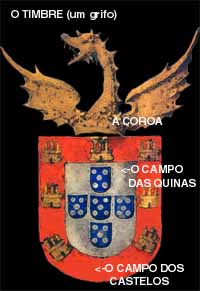The first part (or cycle) of Mensagem ("Message") is very curious in the idea that suggested its structure. Taking a version of a XV century Portuguese coat-of-arms it associates to each of its relevant parts a poem related to the history of Portugal and related to either the fields or the nature of their charges.
The coat-of-arms has two fields: the perimeter, which is the field of the castles (that represent walled towns conquered to the Moors in the XII and XIII centuries); and the central shield which is the field of the escutcheons (called "quinas" in Portuguese and said to represent the five wounds inflicted to the Christ)- see illustration below. Each of these fields suggested a poem: "The Field of the Castles" refers to the land of Portugal and, generically, to materiality; "The Field of the Escutcheons" refers to spirituality. None of the fields (or indeed any of the poems) refers the Portuguese people specifically: Mensagem is a poem about an elite and for an elite. In particular it has been written, not in the orthography current at the time but rather in the classic orthographic rule used before 1920 that was supposed to appeal to educated people.
The poems associated with the fields are followed by a set of poems associated to each of the castles. Each is themed around an heroic figure related in a material way to the origin, growth, or consolidation of the country (including the mythic Ulysses).
Following those comes a set of five poems, one for each of the escutcheons, centered on historical Portuguese figures who, for one reason or the other, had dramatic destinies, including the young King Sebastian who, at 24, died at El-Ksar-el-Kebir, thus closing Portugal's Golden Age.
 |
The crown in the coat-of-arms suggested a poem to Nuno Álvares Pereira the supreme commander of the army who, in the late XIV century, thrice defeated the invading Castilian armies, thus securing the Portuguese independence. Finally the crest (which in the XV century was a griffin) justifies three poems to the three mainstays of the Portuguese Expansion: Prince Henry, the Navigator who launched the maritime explorations, King John II who set the goal of the East Indies and thus determined the future of Portugal, and Afonso de Albuquerque who was the architect and the builder of the Portuguese Empire in Asia. |
Each of the Cycles in Mensagem includes an inscription in Latin which for this part is: BELLUM SINE BELLO (literally "War without the war") which I would translate as "War without battle". This is a Portuguese ideal of power associated with the conscious refusal of violence- we may call it "the peace of the strong" and seemingly is the sumtotal that Fernando Pessoa found to resume in three words the Portuguese way.
Another possible explanation to the inscription would stem from the alternate translation "War without weapons" and in this case an ideal of spiritual rather than material conquest would be implied. This would, presumably, be the way to the Fifth Empire, of which more later. After all, culture is the only (two-way) nonperishable asset that comes out of contact with other populations!